Percich Pond Gazette
Spring Street International School Earth Science News May,
2024

2024
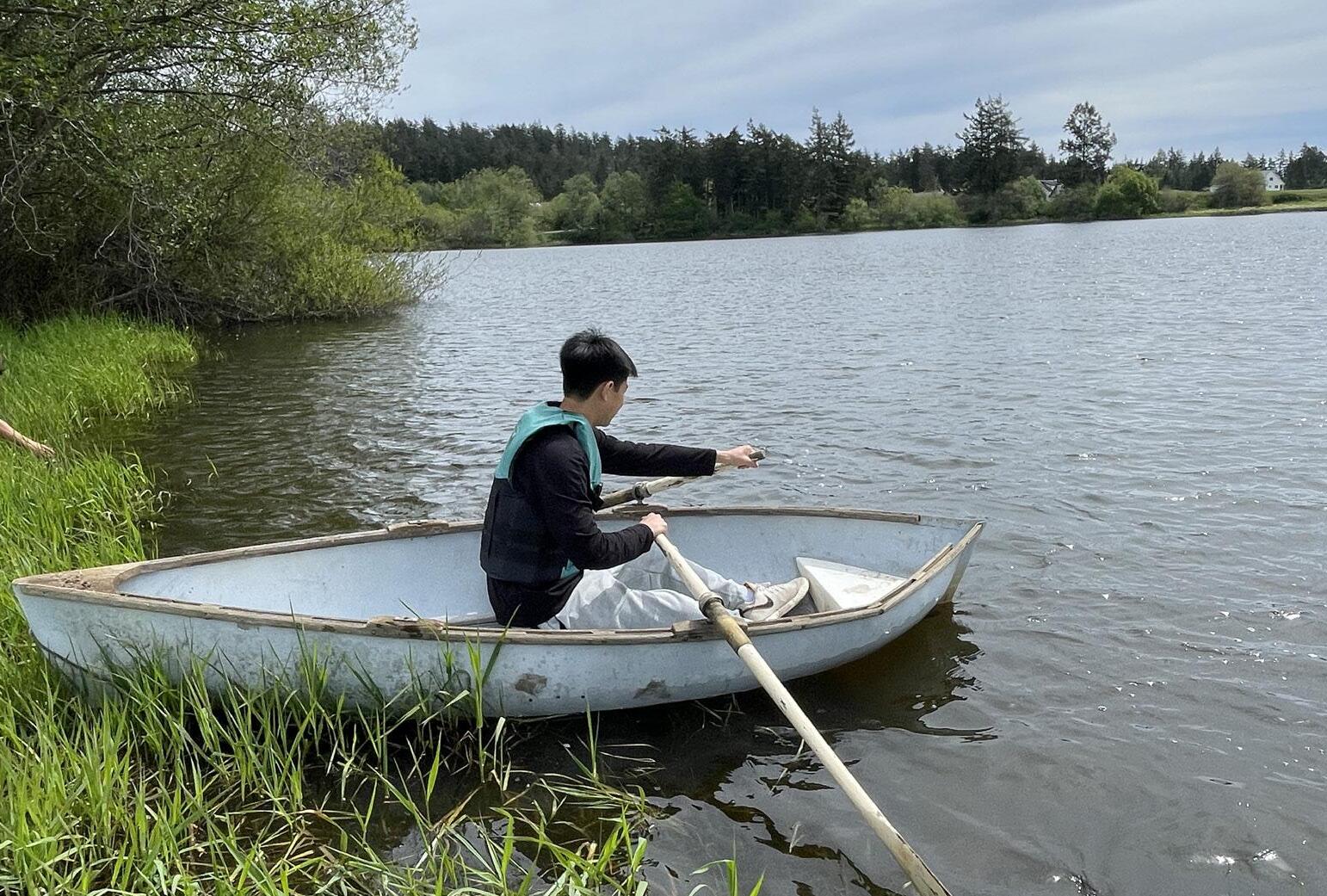 by Eli Lane
by Eli Lane
Our question: Does water quality change between different times of the year, and is there a difference in quality between the bank of the pond and the middle of the pond?
This research is crucial as it sheds light on the nature of water quality in a pond ecosystem.
We chose the topic of water quality because it is essential to know the quality of your water. Knowing the quality
of a body of water can be beneficial because it can tell you if it is suitable for anything being kept or growing in the water, like fish or plants. You can also control excessive algae growth, overgrowth of plants, and dead and dying fish.
Hypothesis: We said that there would be a difference in water quality because of the different conditions throughout the experiment
Our experiment: One of us would get into a rowboat
and go halfway into Percich Pond to collect a bucket of water to bring back to the land. While one person did that, the other would start testing water from the bank. They would fill the testing tubes with the needed amount of water (usually 10ml) and begin to test the water quality. To test the pH of the pond water, we filled the test tube with 10 ml of the pond water; then we would drop one Wide Range pH tablet into the test tube,
(cont. on page 2)
When we first started going to percich pond for science, I got very excited and a bit overwhelmed at the prospect of running an experiment entirely by myself. I had so many choices to make and so many topics I was curious and eager to learn more about. One of the things I was most curious about was learning and exploring the pond and its surrounding area. This posed the question “What kinds of plants and animals live in Percich?” and “Does this change throughout the year based on the seasons?”
And so, the investigation began. I picked a spot along the fence that looked out across most of the property and began observing. My observations became a mix of journal entries/writing and art/sketches. I was so happy knowing that I could figure out a way to incorporate art into science. These weekly observations (and sketching sessions) quickly became a creative outlet for me that gave me a break from what would be considered typical school activities. I now have a collection of sketches that I have created over the past few months that I would like to share with you all. This project was super fun to do and I hope that in the future other students may choose the same project.
inverted it until the tablet was dissolved, then compare the color of the water in the test tube to the key on the water quality testing book. We tested the pond’s turbidity, pH, phosphate, and nitrate levels. We also collected more minor things such as temperature in and out of the water. Results: Looking through the results, there are few noticeable patterns throughout the testing time, although the pH levels did stay relatively close to 7 the entirety of our project, with the most being eight and the least being 6.5. This is good, as a healthy number for a pond is 6.5 to 9. As we first started testing the water, the tests were not very colorful and
dull, but as the year went on, there tended to be an increase of color in the tests and faster results. The color is how we can test the quality with the water monitoring kit. There tends to be a slightly lower amount of everything we have tested near the bank, but no permanent lower or higher depth exists.
What we learned: We thought there would be a difference in water quality throughout the year and a difference at different depths. We were right about the difference throughout the year, as the quality changed a bit. However, there wasn’t much difference in water quality between different depths. There was one
instance, on February 2, where the nitrate levels were very different—5 ppm at the bank and 15 ppm at the middle. However, we don’t have an explanation for this. Overall, Percich Pond is a very healthy pond with quality levels ideal for the teg time.

During this project, I *tried* to monitor the macroinvertebrate population and diversity in Percich Pond and how it fluctuated over time. This investigation was all over the place for me. I had not settled on a definite subject until a couple of months into the project. Even then, I did not collect sufficient and organized data due to a few complications. I had initially wanted to identify the types of microalgae living in the pond, but that was too difficult because microalgae are very, very small. Macroinvertabrates were a step up from that: a project where I could still use a microscope and do a similar identification process, and they also looked cooler. I collected really good samples from the pond, but it was difficult to find enough time to take these samples to a microscope and identify them outside of Earth Science time. And I only had a limited inter-
val post sample-collection for the samples to still be valid. Because I was examining living organisms and putting them in a refrigerator in between uses, they didn’t last long. Throughout all of these challenges, I did not manage to put together a perfect result, but I did get very cool pictures and a consensus that the pond is very healthy.
In the pictures there is a wide variety of macroinvertebrate species: pouch snails, scuds, and different types of fly larvae. The fly larvae are crucial because they can only survive in good quality water, so that indicates how good the water quality is in Percich.
I really hope this project can be continued next year because there’s so much more precise data that can be collected and more conclusions to reach. It’d also be cool to be able to monitor the changes annually, if there were any.
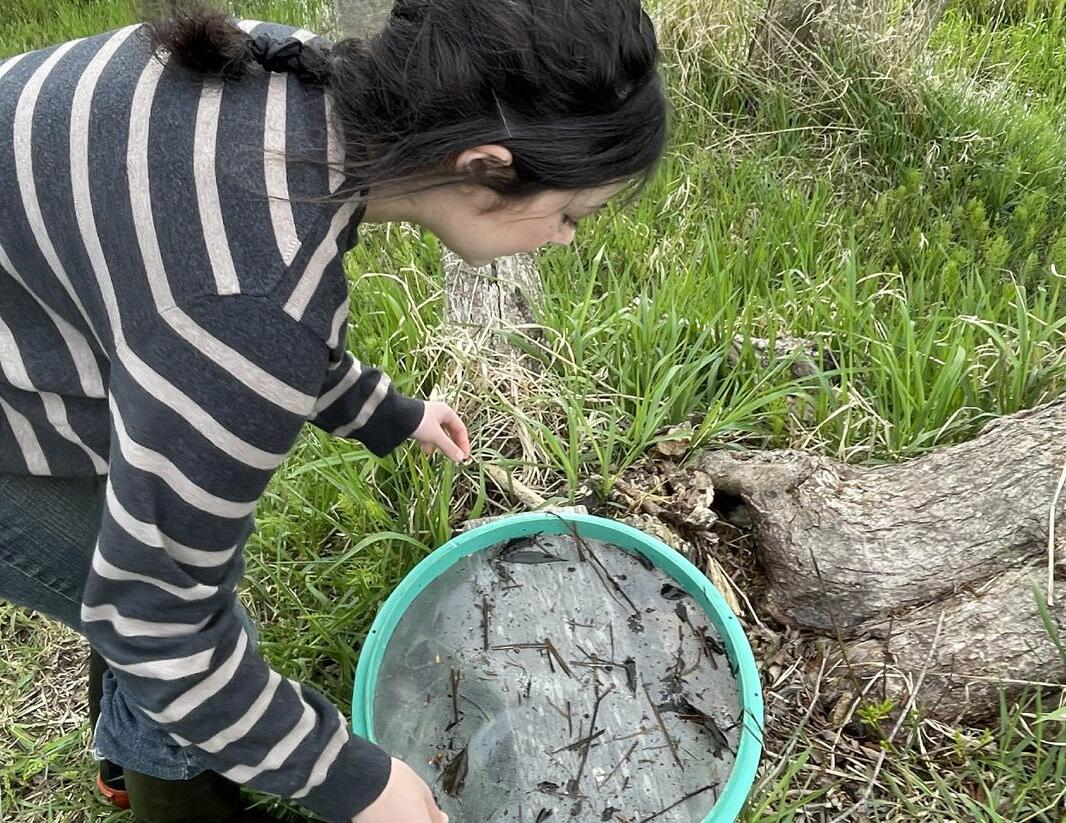





Salutations, residents of Percich Pond, how’s your day been? I actually have another question for you. What do you know about your neighborhood moss? What about lichen? Maybe that there’s lots of it (really), or maybe that you need to clear it from your gutters, but there may be something else you can learn from this not this not so tiny scientist. The best part is, we’ve interviewed her so you don’t have to.
Catherine is an 8th grader at Spring Street International School, and she usually prefers researching from home rather than out in the field. “Sometimes sitting at a desk with a dog on your lap while reading a web-page feels nicer.” She has started a study into the moss and lichen that grow on the trees of Percich pond. Specifically, what among them is most common. “I had to start with background research, and get familiar with the area. That was a part I could do with my dog.” The background research for this study was learning about what trees, moss, and lichen grew in the area. Armed with this knowledge, Catherine set out on her Percich pond adventure.
“Like any old science fair project, I had to come up with my procedure early on.” The first step in her process was background research, which we already went over. She was prepared to set off with her guide books and rain boots to start identifying that moss. “I’m still in that phase actually. I was expecting to be done by now, but we didn’t get as many field days as I was expecting.” This may sound disappointing, but we here at the Percich Pond Gazette can work with it.
When asked about what moss or lichen was most prominent at the pond, Catherine said “There were a few I just kept seeing over and over again. Like, on every tree I looked at, everywhere.” She would then go on to list them off in too much detail for me to actually put in the article. The species were Thelotrema lepadinum (Bark Barnacle), Nephroma resupinatum (Pimpled Kidney), and Quercus garryana (Antlered perfume). She would later make the comment; “I was actually expecting to find Isothecium myosuroides (Cat Tail Moss) on more trees, but I’ve only found it once or twice.”
by Cathy HallMost experiments wind up diverting from the original plan part way through, and this one was no exception. “I had originally planned to see which tree species had the most kinds of moss or lichen growing on it. This would be skewed in favor of whatever species had the largest numbers in the area. Even if all the species had the same amount of specimens at the pond, I can’t exactly ID that little patch of green ten feet up the side of this pine tree.”
As we reach the end of our article, we must know, what would she like to do in the future? “If I were able to continue the study, I would just keep identifying as many species as I can, and keep track of how many of each species I see. Really the same stuff I’ve been doing all along.” As it is now, she already has a pretty wide data set, but she seems set on making it a little wider. “Who knows, maybe there’s a bunch of some new kind I haven’t seen in that area I’ve yet to visit.”
For our last section, we’ll ask a fun question: What were your favorite moments during the study? “I have two, and I
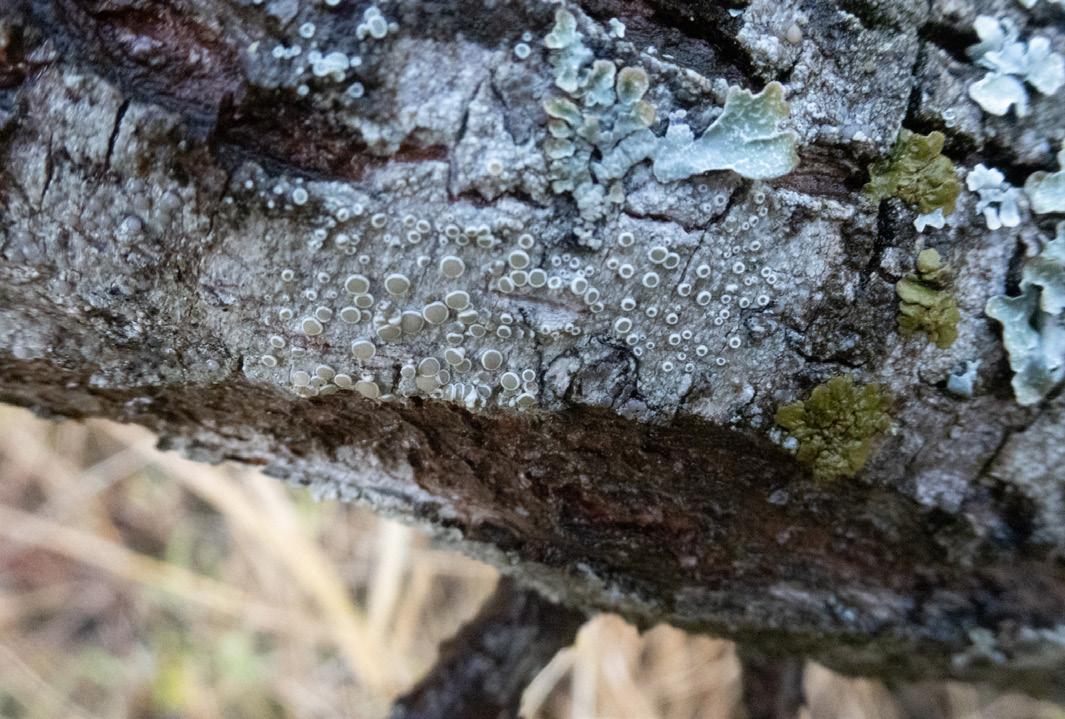
don’t know which one I like more. We had one of the dorm parents drive us out and his daughter would come along too, car seat and all. I was riding back one day when she turned to me and said ‘this is for you’ and gave me a couple of alder cones all on one twig. The other happened at the start of one of our field days, when I was heading towards a new site. There was something blueish propped up against one of the trees. I thought that it might be some lost equipment from another group, so I went to go get it and see if the tree had any moss or lichen. When I actually got to it, it was a statue of a lizard reading a book. A very scholarly lizard indeed. Now, I always think back on it as Mr. Scholarly Lizard.”

For both those who learned things in this article, and those who didn’t, we hope it was enjoyable. Catherine H. of the Percich Pond Gazette (who just wrote an article about herself), signing off.
PS: My dog’s name is Dino.
Our project at Percich Pond was studying the bird population at Percich as we assigned each other certain locations and observed silently as we used binoculars, bird books, and the Merlin app on our phones. We would write down the name of the birds and the amount that we have seen and their actions that they have done such as singing and flying. I have spent most of my time observing birds in area 4 as it was less covered in mud as I didn’t have any boots -- then this became my permanent spot. I would stay by a little hill and would stay standing as I checked what type of bird the app found and write it down on my paper as I have seen barn swallows, ravens,song sparrows, a couple of woodpeckers, and a bald eagle, though I would always have it written as heard cause I related to heavily on the app.I felt that my area had many bird
species as would have written a large amount of birds such as last Friday I saw five Orange Warblers playing or fighting in the air, I mostly see them eat in Peter and Susan’s bird feeder. Which explained the many quantities of birds as Peter and Susan’s bird feeder has attracted lots of birds and they were kind enough to tell me the name of the bird and fun facts about them, Peter was the one that showed me the Dark-eyed Junco and Susan would tell me the name of certain bird chirps and on our last day at the pond two Barn Swallows flew into their house and once they caught them I got to hold them and witness the size of the Barn Swallow as they were smaller than I imagined and I got to see up close the feathers colors and the shade of blue they have on top and their orange bellies. I would like to thank Peter and Susan for sharing their knowledge of birds with

me. I also noticed during our time at Percich was that during winter their were less birds at the pond as most of them have migrated and that during spring many birds have returned, but another of my observations that still stayed consistent was that the Red Winged Black bird was the most common bird that I
saw at Percich. Ways that I would like to see our project go forward Is to see if there are any environmental troubles that the birds are facing at perchich and if climate change is affecting the amount of birds that stay at perchich.

Hi, My name is Kaden and throughout the school year, I have conducted a bird population survey at Percich Pond alongside my classmates Oliver and Rodrigo. Our original question was how will the bird population change throughout the year. We expected that as the weather got better the bird population would increase. To measure the bird population we would go to four different locations on the property where we quietly sit for ten minutes
by Kaden Hornand record all the birds that come into that station. We used binoculars, a bird ID app called Merlin, and a bird ID book to identify the birds.
This graph shows the change in the number of bird species throughout the experiment. The reason that the population dropped on 3/1/24 is because when we were bird watching it was windy so we couldn’t hear any of the birds with the Merlin app.
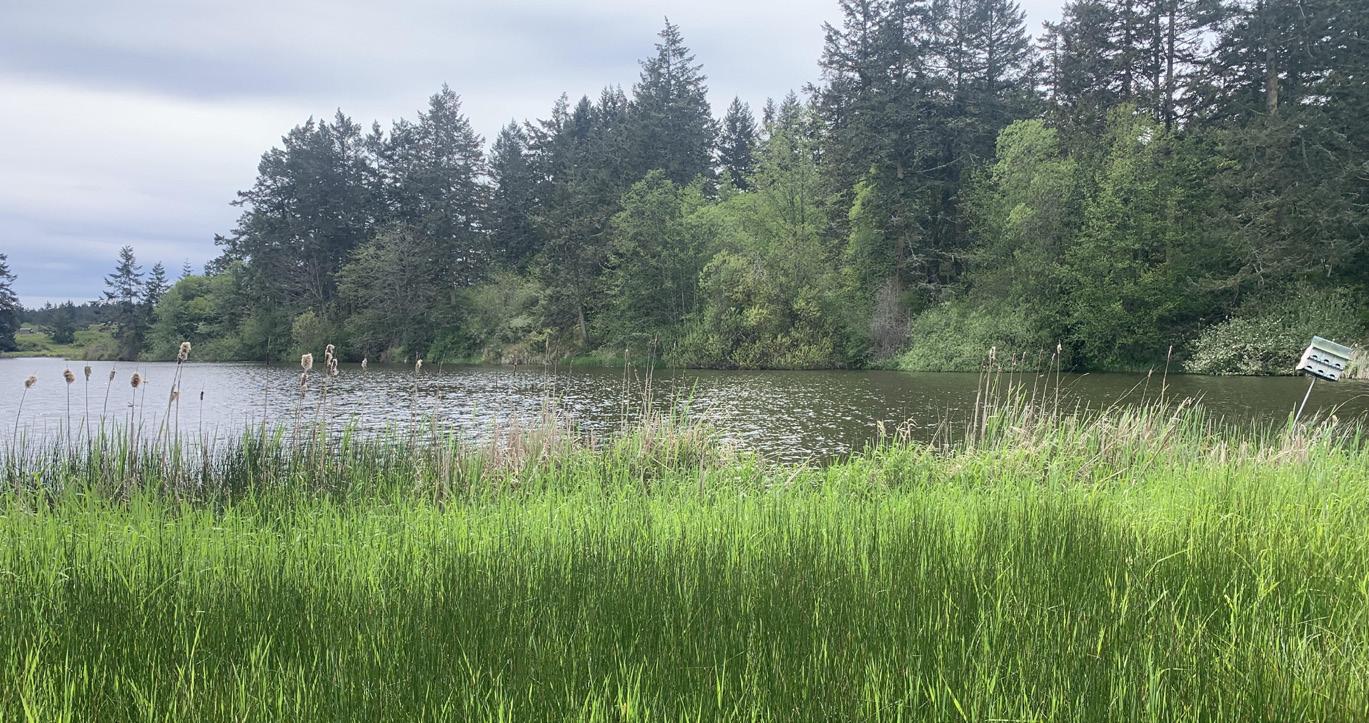
ur teams original question was to see how the birds population at Percich Pond changed over the seasons.
I think that the question has changed a little bit and is now more about the different types of birds and the amount of these birds at different sites. I chose this because I didn’t know that much about the birds at Percich Pond and I wanted to see how much the population would change as it got more into spring.

I spent my time at Percich Pond mostly sitting at site 3 (which is where all my photos are), and recording thebirds that flew by, or were heard.
I also took photos and notes of the site, seeing if anything could affect the birds being there.
I have learned a lot about the birds at Percich Pond such as how Susan helped me at the bird feeder, and told me how to tell the difference between some of the birds. She also told me what some of them look like. In addition I

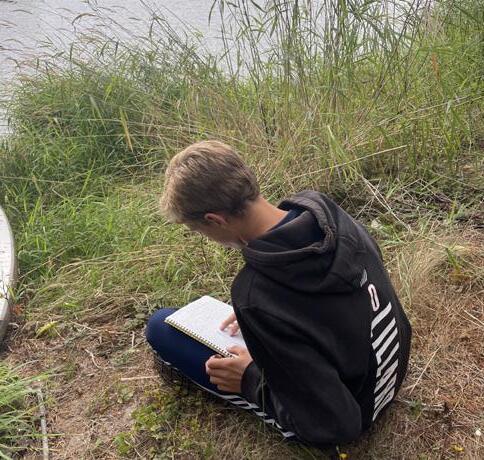

learned what some of the birds sound like, for instance how the red-wing blackbird has a very distinctive sound. I have accomplished many things like learning where the birds favorite spots to sit are, how to tell birds apart from their sounds, and how much the population of the birds at Percich have changed due to it being spring. I would like to see this project being moved forward as the different types of birds at Percich will probably change in the future to things like global warming. I would like
to see my project go forward in other ways too, such as a more accurate way of telling what and how many birds are at certain spots at Percich. Some questions I would like to answer are about how the birds prefer certain areas of Percich and why, because I saw a lot more birds on the other side of the pond. I wonder if that is because of all the noise from us, or just because of other reasons.
Here is a list of the types of birds we found:
Bohemian waxwing
Dark Eyed Junko
American Raven
Bald Eagle
Red-winged Blackbird
House Sparrow
Spotted Towhee
Downy Woodpecker
Annas Hummingbird
Golden Crown Sparrow
Song sparrow
Junco
Tohee
Barn swallow
Snail Kite
White-crowned sparrow
Tree swallow
Orange-crowned Warbler
Huttons viero
House Flinch
Orange warbler
Belted kingfisher
Barn swallow
Brewer blackbird
Barn swallow
Common Raven
Canadian Goose
Downy Woodpecker
Common Crow
Mallard
Yellow-rumped Warbler
American Robin
Great Heron
Hairy Woodpecker
Chestnut-backed Chickadee
Dove
Ruby-crowned kinglet

Background Research and Hypothesis:
Our team embarked on a fascinating journey to explore the diverse mushroom species at Percich Pond. With the hypothesis that seasonal changes would impact mushroom populations, we set out equipped with maps, pencils, data sheets, and a keen eye for discovery.
Materials and Methods:
We used our Percich Pond map, color pencils, and data sheets, and we ventured to designated areas, spots 17 and 18. We thoroughly scanned the surroundings, identifying mushrooms and recording the quantity, species, and edibility. With mushroom identification books, we determined whether the mushrooms were common or rare and noted their edibility status. We also did some sketching and watercoloring the mushrooms we found.
Fall:
In the beginning, we found various mushroom groups at spots 17 and 18, including the “shaggy mane” found past the wooden deck along the trail.
Winter:
As winter approached, the mushroom displays of summer
My project was just seeing what plants grow at Percich Pond and seeing how some of them change over time. I was mainly focusing on daffodils and other little flowers that where next to the daffodils at Percich Pond and I documented through pictures how the daffodils had changed every time I went there, but then I realized
and fall vanished, leaving behind a blank canvas of snowcovered landscapes. We found almost no mushrooms. The ones we did find were dying or already dead.
Spring:
With the arrival of spring, the mushrooms came back! We observed as the tufted coincaps emerged from the ground. totaling 34, near the wooden deck and along the trail beyond it. The weather was sunny with a gentle breeze. Later we also found a Bigger poisonous mushrooms called “Amanita Pantherina” more commonly known as “Panthercap”. It was only there for about 2 weeks before dying. Though when we saw it, it was already fully grown so i’m not sure how long it lasted and when it popped up.
Conclusion:
Our time at Percich Pond revealed the dynamic nature of mushroom ecosystems, influenced by seasons. From the disappearance of summer and fall mushrooms to the reemergence of spring mushrooms, each season offers new mushrooms in the captivating Percich Pond.
that they only bloom once a year, so I just started taking pictures of plants that I saw there. I also took notes about the stuff that I heard and saw when I took time to observe. I would also take a few minutes every time that we went over and just sit and observe.

The purpose of our project was finding medicinal plants and tracking their phenology (how they change over time). Each week we went to Percich and took pictures of them and studied how they changed. We wondered how each plant would change and expected to see a difference because we worked from winter to spring. It would be interesting to continue the project and see how the phenology changes in all the seasons, not just winter and spring. We did research on what medicinal uses they have had in the past and the present. Here are the plants we worked on:
Alder Tree
One of the main things from the alder tree used for medicinal purposes was the bark. Infusions made from the bark of red alders were taken to treat anemia, colds, congestion, and to relieve pain. They were also taken as a laxative and to regulate menstruation. The Pomo, a Native American tribe in California, boiled the bark in water to make a wash to treat skin irritations and sores. As you can see, there was a large change in the alder tree with many new leaves growing.



Cattail
Cattails can be used for wounds, burns, stings, and bruises. The ash of the burned cattail leaves can be used as an antiseptic or styptic for wounds. A small drop of a honey-like excretion, often found near the base of the plant, can also be used as an antiseptic for small wounds and toothaches. In the time we were observing it the cattail gained a lot of fluff.

Swordtail Fern
An infusion of the swordtail fern stems or poultices of chewed leaves were used to treat skin sores and boils, and a decoction of rhizomes could be used as a wash for dandruff. The fern itself did not change a lot, the main change was in the growth around it.


Bracken Fern
Bracken fern is used in a wide variety of ailments including nausea, stomach cramps, rheumatism, and headaches. The only big change we saw was that a lot of the dead ferns fell away, and there were some new fronds, although you can’t see it in the photo.


Lichen is used in traditional medicine and is most commonly used for treating wounds, skin disorders, respiratory and digestive issues, and obstetric and gynecological concerns. The lichen did not change very much except for decrease in the quantity, but the tree it was on gained a lot of new leaves.

 Alder Tree
Alder Tree
Cattail
Cattail
Swordtail Fern
Swordtail Fern
Bracken Fern
Bracken Fern
Lichen
Lichen
Lichen
Alder Tree
Alder Tree
Cattail
Cattail
Swordtail Fern
Swordtail Fern
Bracken Fern
Bracken Fern
Lichen
Lichen
Lichen
Ngozy and I decided to investigate the soil at Percich Pond. Our original question was “How acidic is the soil near Percich Pond throughout the year, and is the distance from the pond relevant?” This topic interested us because soil acidity (PH) was something we had never really thought about before, and we wanted to know more about it. The PH of soil also decides what plants can grow in that soil. The strange thing about PH, is that an increase in PH actually means a decrease in acidity. For example, soil with a PH of 7, would be less acidic than soil with a PH of 6. Also, each decrease in PH represents a 10x increase in acidity, meaning that the soil with a PH of 6 would be exactly 10x as acidic as the soil with a PH of 7. At first we also wanted to measure the potash, phosphorus, and nitrogen levels in the soil, but the kit we had took too long to get the results back, so it was hard to get a definitive outcome.

Our first few days at Percich were about experimenting. We explored the area to find 2 good spots to sample that varied in distance from the pond, and took some time to learn how to use our soil test kit and the rest of our equipment. After 2 or 3 Percich days, and a few more in-class work days, we had developed our process. At each site we first measured the temperature of the soil. Then we sampled a little bit of soil, mixed it with distilled water and some powder from our test kit, shook it to mix up the solution, then let it sit for a minute. We then looked at the color of the solution, and matched it to a color key

to get our final results. For a trip or two, we forgot to bring distilled water, so we eventually had to scrap those sets of data.
Our hypothesis was that if the moisture content in the soil increases then the acidity of the soil will increase, because as rain and other types of moisture go through the soil and suck out the basic nutrients, (calcium, magnesium, ect.), they are replaced by more acidic elements, such as aluminum and iron. This in turn causes the PH levels to decrease. We hypothesized that the acidity levels will reach their maximum in winter, and then decrease as the weather gets warmer/drier in spring
and summer. As we expected, site 2 (far from water) had the highest PH (lowest acidity). The soil’s PH rose as the year went on and the weather got warmer and drier.
In the future, I think it’d be interesting to get amore accurate method of testing. That would be especially helpful since a small change in PH is a big change in acidity. Measuring more outside variables like other nutrients in the soil would also be beneficial to know just why the PH changes. I also wonder how much the PH would keep changing if we did a year-round investigation instead of one that just lasts a few months.

 by Grace Holding, Denali Sommer & Henry Holloway
by Grace Holding, Denali Sommer & Henry Holloway
Our project is looking at the depth of the lake. We have been seeing slight changes throughout the lake, we first started in the fall/winter and the lake and surrounding the lake we have noticed that it has been raining and flooding more in the spring than winter. A couple of times we found dead fish in the lake when paddling on our canoe. around. Overall there wasn’t much of a change throughout the fall, winter, and spring. We have noticed that lily pads have been changing where they are in the lake and are not in their original spot. Henry is in the middle of the canoe and he has the earth science notebook, pencil, and
a measurement wheel which has a weight on the bottom, weighing it down so it can drop into the water. Denali is in the stern, steering and Grace is in the bow. We have learned to really stay still and not mess around because a couple of times we have almost capsized. This project was very interesting and fun to do. It is a project I would recommend doing if you are going into 8th Grade next year.
Crossword
